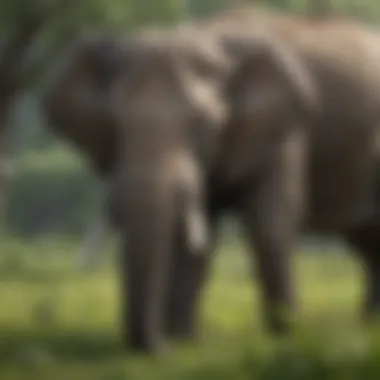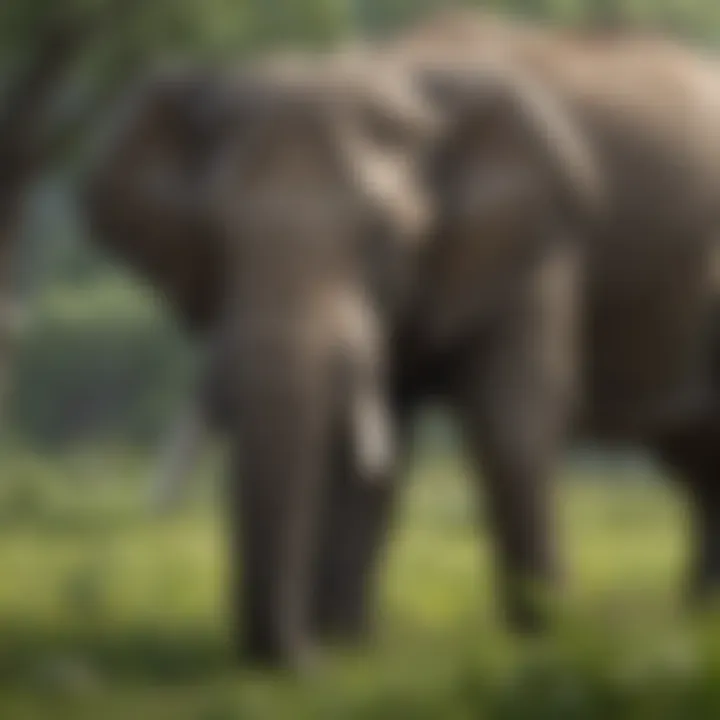Exploring the Dietary Preferences of Elephants in the Wild


Nature Topic Overview
Elephants, the gentle giants of the animal kingdom, have fascinating dietary habits that are crucial to their survival. Understanding what they eat gives us insight into their behavior, health, and how they interact with their environment. Their diet mainly comprises of grasses, leaves, fruits, and bark. This variety is not just a reflection of their size; it’s essential for maintaining their massive bodies and energy levels.
As herbivores, elephants spend a significant portion of their day - around 12 to 18 hours - foraging for food. Depending on their habitat and the season, their diet will shift. For instance, during the rainy season, they might feast on tender grass, while in the dry season, they might rely on tree roots and bark. Understanding these preferences helps give a clearer picture of their ecosystems and the delicate balance they maintain within it.
Fun Facts and Trivia
Did you know that elephants can consume up to 300 pounds of food in a single day? That’s like eating a small car! Here are some more cool facts:
- Elephants use their trunks not just to eat but to dig for water and bathe.
- An elephant's diet varies significantly based on its age - younger elephants often stick to softer leaves and fruits.
- They can travel up to 20 miles a day searching for food.
To make this engaging for kids, perhaps a fun quiz could be created:
- How much food do elephants eat a day?
- What do baby elephants eat?
- Can elephants swim?
Wildlife Explorations
Within the elephant’s habitat, many other species thrive. For example, other herbivores like zebras and giraffes share similar feeding grounds, although they often graze on different vegetation to avoid competition. Additionally, various plants that can be found in the savannah or jungle play an essential role in sustaining not just elephants, but a whole ecosystem.
A great way to learn more might be to explore the differences between African and Asian elephants. Did you know that African elephants are generally larger and have bigger tusks than their Asian cousins?
Interactive Feature:
A fun activity for young readers could include matching animals to their favorite foods, reinforcing their learning about the animals sharing the same environment.
Environmental Awareness
Understanding the dietary needs of elephants also ties into broader issues of conservation. When humans encroach on wild habitats, it can disrupt these magnificent creatures’ feeding patterns. For instance, deforestation can eliminate vital food sources for elephants, leading to malnutrition and population decline.
Kids can play a role in protecting nature:
- Encourage recycling and reducing waste at home.
- Participate in local clean-up efforts in their communities.
- Learn about the importance of trees and why we should plant more.
DIY Nature Activities
Hands-on learning can make a significant impact on how children connect with elephants and nature. Here are a few DIY activities:
- Create an Elephant Food Chart: Using paper and crayons, kids can draw and label different foods elephants might eat, presenting their findings to family and friends.
- Nature Scavenger Hunt: Kids can go on a scavenger hunt in their backyards or local parks to find plants that elephants eat. They can take pictures or sketch what they find!
- Elephant Craft: Using recycled materials, children can create a model of an elephant and its habitat, illustrating the kind of environment they thrive in.
These activities not only provide family fun but also emphasize the value of respecting wildlife.
"Conservation isn’t just a concept; it’s an urgent call to action for the world’s future. Every small step counts." - Unknown
By exploring the intricate food preferences of elephants, children will grasp the importance of nature conservation and the need to protect the habitats that support these remarkable creatures.
Understanding Elephant Diets


Understanding Elephant diets is key to grasping the overall well-being of these magnificent creatures. Elephants, the largest land animals, have distinct eating habits that reflect their environment, social structures, and biological needs. Knowing what elephants eat, how they find their food, and what influences their dietary choices can help us appreciate these gentle giants and recognize the importance of their ecosystems.
Elephants consume up to 300 pounds of food daily, which points to their immense size and high energy needs. This article offers a peek into the intricacies of an elephant's diet, considering varied factors like habitat, age, and seasonal changes. Knowledge about their eating preferences isn't just interesting; it’s essential for conservation efforts and for fostering an appreciation in younger generations about wildlife and nature.
What Constitutes an Elephant's Diet
At the heart of an elephant's diet lies a variety of vegetation tailored to their needs. Elephants primarily feast on:
- Grasses: These make up a substantial part of their meals. During the rainy season, fresh, nutrient-rich grasses are plentiful, and elephants gravitate to these lush patches.
- Fruits: Elephants have a sweet tooth, and fruits like bananas, mangoes, and, on occasion, apples are irresistible treats for them. They’re often seen raiding orchards in search of a tasty snack.
- Bark and Leaves: The thick bark of trees is not merely a snack. Elephants have strong tusks that allow them to strip bark, obtaining essential nutrients hidden beneath the surface of tree trunks.
The diversity in their diet is influenced by their habitat, which can range from savannahs to forests. The varieties of plants available in these ecosystems dictate what elephants will eat, showcasing their adaptability.
The Nutritional Needs of Elephants
Elephants, just like people, have specific nutritional needs that are essential to their health. They require a balanced diet rich in:
- Fiber: Vital for digestion; elephants need ample forage to keep their digestive systems running smoothly.
- Vitamins and Minerals: These are critical for growth and overall health. Certain minerals like calcium and phosphorus are particularly important as they contribute to bone health and reproductive success.
- Water: Hydration is another crucial part of their nutritional needs. Elephants can drink up to 50 gallons of water a day to stay hydrated, especially in warmer climates.
Feeding behavior may also shift with the seasons. In the rainy season, elephants can munch on fresh vegetation, while during dry spells, they rely more on bark and roots, showcasing their resilience.
"Understanding what elephants eat helps us create a conservation plan to protect their habitats."
Overall, the diets of elephants are crucial not just for their survival, but for the ecosystems that depend on their feeding habits, such as seed dispersal and landscape management. As we delve deeper into their preferences and influences, we gain a clearer picture of how vital these creatures are to their environments.
Types of Food Elephants Prefer
Understanding what elephants eat is crucial. It gives learnes insights into their natural behavior, their ecosystem, and their overall well-being. Elephants are herbivores, meaning they primarily eat plants. Knowing the types of food they prefer helps us recognize the importance of their diets for maintaining healthy populations in the wild. Let’s dive deeper into the specific food choices elephants make.
Grass: A Mainstay in Their Diet
Grass holds a special place in an elephant’s daily meal plan. It’s often the first choice, especially in certain habitats like savannas or grasslands. Elephants can consume a staggering amount of grass, sometimes reaching up to 300 pounds a day! This grass not only provides essential nutrients but also keeps their enormous bodies properly fueled.
Different types of grasses can vary in nutritional content, with some providing more fiber and others richer in proteins. Elephants are particularly fond of grass species like Pennisetum or Cynodon. Once these grasslands dry up, elephants may travel long distances to find greener pastures. This behavior highlights how their feeding patterns are interconnected with their habitat and seasonal changes.
Fruits: A Tasty Treat
When it comes to fruits, elephants have a fine palate. They enjoy a diverse range of fruits, which are often sweet and juicy, making them a delightful snack. Common fruits in their diet can include bananas, mangoes, and even watermelons. These fruits are loaded with vitamins, providing necessary dietary diversity.
Not only do they satisfy hunger, but fruits also offer hydration, especially in dry seasons. However, fruits can be seasonal. For instance, elephants often have to look forward to specific times of the year when their favorite fruits like jackfruit or tamarind are ripe and abundant. Their ability to adapt to eating what’s available is quite impressive.
Bark and Leaves: Nutritional Sources
Bark and leaves might not sound too appealing, but for elephants, they're essential sources of nutrition. The intricate network of an elephant's molars allows them to grind tough plant material effectively. The bark from trees like Acacia or Baobab is rich in fiber and minerals, which are critical for elephants.
They often strip bark from trees, which helps in their foraging. This action not only nourishes them but also aids the ecosystem by promoting new growth in trees. Leaves, particularly young and tender ones, are also highly nutritious and can be consumed in large quantities, especially when other food sources are scarce.
Water Sources: Essential for Hydration
Water is life, and for elephants, it plays a vital role in their dietary preferences. These majestic creatures can consume up to 50 gallons of water per day, especially in hot weather. They seek out reliable water sources like rivers, lakes, and ponds.


Water isn’t just about drinking, though. It helps them in digestion and is crucial for their overall health. Elephants often use their trunks to dig to reach underground water sources during dry spells. This behavior highlights their intelligence and the adaptation they have developed for survival in diverse environments. Access to clean water is also central to their feeding behavior, as it affects how and where they forage.
"Understanding elephants' diets is not just about what they eat but how they live in harmony with nature."
In summary, elephants have a diverse range of food preferences—each type of food plays a unique role in their health and survival. By exploring these choices, we gain deeper insights into their life and the ecosystems they inhabit.
Influences on Feeding Behavior
Understanding what influences how elephants eat is quite important. It gives insights into their lifestyles and survival strategies. Just like humans have preferences, elephants show distinct feeding habits based on various factors. These are not only shaped by their biological needs but also influenced by their surroundings and social structure.
Age and Dietary Needs
Just like people eat different things as they grow, the diet of elephants also changes with age. Young calves are typically weaned off their mother's milk at about two to three years, and their taste buds start expanding. Initially, they consume softer grass and tender leaves. As they grow older, their jaws and teeth develop, allowing them to munch on tougher vegetation. Older elephants, on the other hand, may encounter difficulties chewing those same kinds of food they once enjoyed. If an elder elephant loses teeth, it will affect their ability to eat. Older elephants, therefore, sometimes prefer softer browse or even fruits that require less effort to chew.
Seasonal Variations in Food Availability
Food sources are not constant; they change with the seasons. In rainy seasons, grasses flourish and become abundant, providing nutritious meals for the elephants. But as dry months roll around, these grasses vanish like morning dew. Elephants adapt well — they adjust their diet according to what's available. During these lean months, they will depend more on tree bark or even roots. Understanding the elephant's flexibility is crucial for their survival, showing how they thrive in changing environments rather than following a narrow feeding pattern.
Environmental Factors Affecting Diet
Environmental changes can also significantly affect an elephant's diet. Habitat quality, for instance, plays a vital role. In some regions, deforestation or human encroachment limits the variety of vegetation available. Without a rich assortment of food, elephants might experience poor nutrition, affecting their health. Similarly, climate change can alter the distribution of vegetation and water sources, impacting their access to food. Another factor is competition. When resources are scarce, elephants might struggle with others for food, forcing them to change their usual feeding habits. This flexibility is remarkable; elephants adjust and conserve energy to survive.
Understanding how various influences affect elephants’ feeding behaviors is crucial. It aids in conservation efforts, allowing us to comprehend their needs and the pressures they face.
By grasping these elements, we can better appreciate not only the eating habits of these magnificent creatures but also the larger ecological picture surrounding their survival.
The Role of Social Structures
The intricate social dynamics among elephants play a vital role in shaping their feeding behaviors. Elephants are not solitary creatures; rather, they thrive in matriarchal family groups that consist of mothers, their offspring, and sometimes other related females. This structure offers several advantages, both in terms of survival and nourishment. Family units provide protection from potential dangers, such as predators, and help locate food sources in vast landscapes.
Group cohesion helps elephants navigate their environment effectively, as they communicate and cooperate while foraging. The social bonds also enable them to share knowledge about the locations of water sources and nutritious feeding grounds, crucial in maintaining a well-balanced diet.
How Family Groups Influence Feeding
The influence of family groups on an elephant's diet cannot be overstated. Adult females, particularly matriarchs, lead the way in identifying safe and nutritious food options. Their extensive experience provides younger elephants with critical knowledge about which plants are palatable and nutritious versus those that might be harmful.
- Foraging Strategies: The family often works together while foraging. This not only makes the task easier but also allows them to discover new food sources. For example, while a matriarch may be skilled at locating underground tubers, younger elephants can quickly learn these skills through direct observation and mimicking.
- Feeding Locations: Families tend to travel together to certain feeding areas known to be rich in preferred grasses or fruit-bearing trees. This consistent gathering at specific spots is essential, especially in regions where food availability changes throughout the seasons. Learning these routes is an important social and survival skill imparted from one generation to the next.
Learning from Elders: Passing Down Knowledge
Elders within the group play a crucial role in educating younger elephants. This knowledge transfer process is fundamental for survival in the wild. The intricate web of communication among elephants ensures that the wisdom acquired through years of foraging and survival is not lost.
- Observation and Imitation: Younger elephants learn largely by watching the actions of older members. For instance, when a matriarch finds a tree with rich bark or leaves, younger elephants will closely observe her techniques. This visual learning is instrumental, as elephants tend to have a strong memory, allowing them to recall the locations and types of food that have been successful in the past.
- Vocalization and Body Language: Communication isn’t solely about sound. Elephants use a variety of vocalizations, body postures, and even vibrations in the ground to convey messages about food sources. Through playful interactions and mimicry, the younger elephants pick up on these essential cues.
Learning from elders emphasizes the importance of social structures and groups, providing a nurturing environment that facilitates growth, understanding, and the sharing of wisdom as they navigate their complex landscapes in search of sustenance.
"Elephants are not only masters of survival; they are also teachers, passing down lessons of life and nourishment across generations."


As we delve deeper into how social structures influence elephants’ dietary preferences, we see that their communal lifestyle isn’t just a social arrangement; it’s a cornerstone of their survival strategy.
Human Impact on Elephant Diets
The relationship between humans and elephants is a tangled web, often filled with both hope and despair. The impact humans have on elephant diets is not just a matter of numbers; it reflects our evolving understanding of conservation and the ripple effects that arise from altering nature. One primary concern is how human activities influence the availability of food sources that elephants rely on. This section dives into the profound implications of habitat loss, poaching, and conservation efforts, shedding light on why these issues matter greatly.
Habitat Loss and Its Consequences
Habitat loss is perhaps the most pressing challenge elephants face today. As cities expand and farmland increases, the natural environments where elephants roam have been reduced significantly.
- Deforestation: Trees, which provide fruit and bark, are cut down for timber and agriculture. With fewer trees, elephants often find themselves searching for food farther away from their usual spots.
- Fragmentation: Even when some habitats remain, they are often separated by roads or other barriers. Elephants, being social creatures, travel long distances to find food and mates. When these pathways are blocked, it disrupts their feeding habits.
The consequences of such habitat loss are dire. Not only do elephants find it harder to locate their preferred foods, but they also experience increased competition with other species for the limited resources. This can lead to malnutrition and even affect elephant reproduction rates.
Poaching and the Demand for Ivory
The illegal trade of ivory is a deep, dark cloud hanging over elephant populations. Poaching not only threatens their existence but also disrupts their natural feeding behaviors.
- Targeting Older Males: Many poachers specifically hunt older male elephants for their tusks. Removing these mature individuals from the herd has consequences, as they often guide younger elephants to food and water sources.
- Instilling Fear: The constant threat of poaching can make elephants more cautious in their daily routines. They may avoid certain areas that provide food and water, simply out of fear of human encounters.
This creates a vicious cycle, where the decline of elephant populations due to poaching leads to a loss of ecological knowledge within herds, further complicating their ability to find necessary resources.
Conservation Efforts and Their Importance
Despite the gloom surrounding human impacts, there’s a glimmer of hope. Conservation efforts aimed at protecting elephants are gaining momentum and recognition.
- Protected Areas: Many countries are establishing wildlife reserves and national parks to safeguard elephant habitats. These protected areas ensure that elephants have access to their natural food sources without fear of human interference.
- Education Initiatives: Teaching communities about the importance of elephants in their ecosystems is crucial. When people understand that protecting elephants also benefits their own environments, they are more likely to support conservation efforts.
- Sustainable Practices: Encouraging farmers to adopt sustainable agricultural methods can minimize habitat destruction, allowing elephants to thrive alongside human populations.
"Conservation is not just about saving elephants; it's about ensuring a balanced ecosystem for future generations."
Through collaboration between governments, local communities, and wildlife organizations, it’s possible to mitigate the negative impacts that humans have had on elephant diets. Together, we can work toward a world where elephants continue to roam freely and where their dietary needs are met by a flourishing habitat.
Encouraging Awareness About Elephants
Understanding elephants is crucial, not just for their survival, but for the ecosystem they inhabit. The more we know about these gentle giants, the better we can help them live in harmony with humans. Heightened awareness can lead to significant changes in attitudes and behaviors toward elephants. Learning about their diets, social structures, and the threats they face can inspire individuals, especially children, to take action.
Involving young learners is paramount in fostering a future generation that values wildlife conservation. Teaching kids about the importance of elephants can ignite their curiosity and compassion. This lays a strong foundation of empathy toward these magnificent creatures. Elephants are not just animals; they play a key role in their environment by maintaining the health of the ecosystems where they roam.
"Awareness is the first step towards protection."
As children learn about how vital elephants are to their habitats, they’ll see how interconnected life truly is. The food they consume, like fruits and grasses, helps shape their environment, creating habitats for countless other species. This interconnectedness exemplifies why conserving elephants is essential for maintaining biodiversity.
How Kids Can Help Elephants
Kids have a special way of seeing the world, and their enthusiasm can make a big difference in elephant conservation. Here are a few ways they can contribute:
- Educate Peers: Sharing what they learn about elephants can create ripple effects in their communities. Kids can organize talks or share stories to spark interest among friends.
- Participate in Fundraisers: Getting involved in fundraising activities can directly benefit elephant conservation organizations. Simple bake sales or art fairs can generate funds for important projects.
- Adopt an Elephant: Many organizations offer symbolic adoptions. Kids can adopt an elephant, which helps fund its care and conservation efforts.
- Spread Awareness: Whether through social media or school projects, spreading the word about the importance of elephants helps others become aware.
The Importance of Education in Conservation
Education is the backbone of effective conservation efforts. By teaching children about elephants and their habitats, we empower them to be advocates for change. Knowledge enables young minds to appreciate the unique qualities of elephants, fostering a sense of responsibility.
Understanding the impact of habitat loss and the need for sustainable practices is key. Educating children about these topics encourages them to think critically about environmental issues. It also highlights their potential role in combating these challenges.
- Curriculum Development: Schools can incorporate elephant-focused curricula to ensure kids receive solid information about wildlife.
- Interactive Learning: Museums and zoos often have programs where kids can engage directly with the subject matter, making learning fun and impactful.
- Field Trips: Taking children to reserves or national parks can lead to memorable experiences, linking what they've learned in classrooms with real-life observations.







